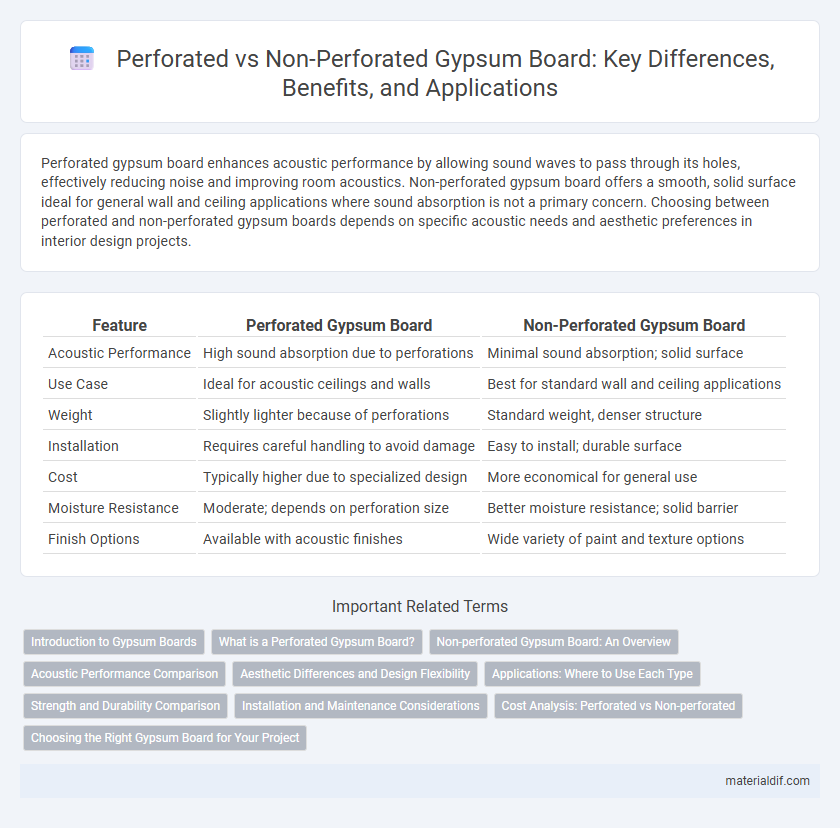Perforated gypsum board enhances acoustic performance by allowing sound waves to pass through its holes, effectively reducing noise and improving room acoustics. Non-perforated gypsum board offers a smooth, solid surface ideal for general wall and ceiling applications where sound absorption is not a primary concern. Choosing between perforated and non-perforated gypsum boards depends on specific acoustic needs and aesthetic preferences in interior design projects.
Table of Comparison
| Feature | Perforated Gypsum Board | Non-Perforated Gypsum Board |
|---|---|---|
| Acoustic Performance | High sound absorption due to perforations | Minimal sound absorption; solid surface |
| Use Case | Ideal for acoustic ceilings and walls | Best for standard wall and ceiling applications |
| Weight | Slightly lighter because of perforations | Standard weight, denser structure |
| Installation | Requires careful handling to avoid damage | Easy to install; durable surface |
| Cost | Typically higher due to specialized design | More economical for general use |
| Moisture Resistance | Moderate; depends on perforation size | Better moisture resistance; solid barrier |
| Finish Options | Available with acoustic finishes | Wide variety of paint and texture options |
Introduction to Gypsum Boards
Perforated gypsum boards are designed with evenly spaced holes to enhance acoustic performance by absorbing sound, making them ideal for noise control in commercial and residential spaces. Non-perforated gypsum boards provide a smooth, solid surface primarily used for wall and ceiling construction, offering structural stability and fire resistance. Both types are composed of gypsum plaster sandwiched between layers of paper, but their functional differences cater to varying interior design and building requirements.
What is a Perforated Gypsum Board?
A perforated gypsum board is a type of drywall panel designed with a series of small, evenly spaced holes to enhance acoustic performance and sound absorption in interior spaces. These perforations improve sound diffusion and reduce noise levels, making them ideal for environments like auditoriums, offices, and conference rooms. Unlike non-perforated gypsum boards, which primarily provide structural and fire-resistant properties, perforated boards combine these features with superior acoustic control.
Non-perforated Gypsum Board: An Overview
Non-perforated gypsum board offers a smooth, solid surface ideal for painting and wallpapering applications, providing excellent fire resistance and sound insulation properties. It is commonly used in walls and ceilings where a clean, uniform appearance is required without acoustic treatment. This type of gypsum board is highly durable, moisture-resistant variants are available for use in bathrooms and kitchens, enhancing its versatility in construction projects.
Acoustic Performance Comparison
Perforated gypsum boards provide enhanced acoustic performance by allowing sound waves to penetrate and dissipate within the hollow spaces behind the board, effectively reducing noise and reverberation levels. Non-perforated gypsum boards primarily act as sound barriers with limited absorption capabilities, reflecting most sound waves back into the environment. The choice between perforated and non-perforated gypsum boards significantly affects sound insulation quality in building applications such as auditoriums, offices, and residential spaces.
Aesthetic Differences and Design Flexibility
Perforated gypsum boards offer enhanced design flexibility by allowing acoustic treatment integration, creating visually appealing patterns that improve sound absorption without compromising aesthetics. Non-perforated gypsum boards provide a smooth, uniform surface ideal for sleek, minimalist designs but lack the texture variety and acoustic capabilities of perforated options. Choosing between them depends on the balance between aesthetic preferences and functional requirements such as noise control in interior spaces.
Applications: Where to Use Each Type
Perforated gypsum boards are ideal for acoustic treatments in spaces like auditoriums, conference rooms, and theaters where sound absorption is essential. Non-perforated gypsum boards are commonly used in residential and commercial walls and ceilings where a smooth, uninterrupted surface is required for painting or wallpapering. Selecting the appropriate type depends on whether sound control or surface finish is the primary design consideration.
Strength and Durability Comparison
Perforated gypsum boards offer enhanced acoustic properties but generally have reduced strength and durability compared to non-perforated gypsum boards due to the holes compromising structural integrity. Non-perforated gypsum boards maintain higher load-bearing capacity and resistance to impact, making them more suitable for areas requiring robust wall or ceiling applications. The thickness and density of non-perforated gypsum boards contribute significantly to their superior durability in construction environments.
Installation and Maintenance Considerations
Perforated gypsum boards simplify installation by reducing weight and enhancing acoustic performance without requiring additional soundproofing layers, unlike non-perforated boards that often need extra insulation for noise control. Maintenance of perforated gypsum boards involves regular dusting and careful cleaning to prevent clogging of holes, while non-perforated boards demand less frequent cleaning but are more susceptible to visible damage from impacts. Both types require proper sealing and joint treatment to maintain structural integrity and aesthetic appearance over time.
Cost Analysis: Perforated vs Non-perforated
Perforated gypsum boards typically have higher initial costs due to specialized manufacturing and added acoustic benefits, but they can reduce expenses on soundproofing materials in the long term. Non-perforated gypsum boards are generally more affordable upfront but may require additional investments for acoustic treatment in noise-sensitive environments. Evaluating total project costs must account for installation, material durability, and performance efficiency related to sound absorption needs.
Choosing the Right Gypsum Board for Your Project
Perforated gypsum boards enhance acoustic performance by absorbing sound, making them ideal for theaters, conference rooms, and office spaces requiring noise control. Non-perforated gypsum boards provide a smooth, solid surface suitable for standard wall and ceiling applications where aesthetics and fire resistance are primary concerns. Selecting the right gypsum board depends on balancing acoustic needs, structural requirements, and design preferences to optimize functionality and comfort in your project.
Perforated gypsum board vs Non-perforated gypsum board Infographic

 materialdif.com
materialdif.com